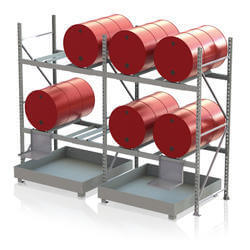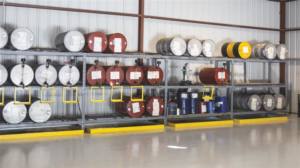A good maintenance program can be the defining factor in the productivity and performance of a production line. Professionals who work in the industry know that lubrification is a very important part of the maintenance program, and so are the best practices for storage and handling said lubricant.
In this article, we are going to discuss some of the recommended practices when designing a system to store and handle your lubricant. The ideal system will preserve the quality of your lubricant for as long as possible.
The handling of lubricants must be careful from their arrival up until the point where they are actually used. It is important that between these two points they are kept clean and at the right temperature.
Lubricant Storage and Handling – A Proper Space is the First Step
The first thing to consider when designing a system to best storage lubricants is the development of a good “lubricant space”. The purpose of this space is to store your lubricants in one safe area where they can’t be contaminated by outside factors.
This space can be outdoors or indoors, each one with its specific set of practices to ensure you’re storing your lubricant as best as possible. In both cases, it is recommended that you use proper storage racks and pallets to store the lubricants.
Outdoor Space
Ideally, lubricants must be stored indoors. However, due to financial or environmental factors, this is not always possible. When that’s the case, they need to be very well protected and sheltered against rain and any other elements.
Moisture is your worst enemy when storing lubricants outside. To avoid that, the drums need to be stored horizontally with the seals below the lubricant level.
If the drums absolutely have to be stored upright, protect their covers or tilt them slightly to prevent the accumulation of moisture on top.
You also want to prevent long storage periods, so develop a system to track the consumption of lubricants in a way you can replenish them at the right moment to avoid exposure as much as possible.
Indoor Space
Indoors your lubricants are protected from environmental factors, but there are still some practices you need to be mindful of.
The lubricant storage room must be located as far as possible from other possible industrial contaminations, especially humidity. The room must be kept clean and dry at all times and always at moderate temperature.
Just as outside, if possible you still want to store them horizontally, but if they need to be stored upright you need to protect them with a drum cover or tilt them slightly.

Labeling and Organization – As Important as Storage and Handling
Labeling your lubricants is extremely important and, unfortunately, often overlooked.
The labeling process helps identify the exact kind of lubricant stored in a drum, as well as other important information like date of arrival, purpose, and life cycle.
To label, use materials that will not fade over time in conjunction with legible and clear identification. The system must also be familiar to everyone working with the lubricants, with any information deemed necessary to the proper organization and fluidity of work.
Packaging and Bulk Storage – What Suits Your Needs?
So far we have been talking about “drums”, but only because they are the most common form in which lubricants are commercialized. There are other types of containers and packaging systems for you to choose from.
The most common forms of containers in which lubricants can be sold are pails (20 liters), drums (200 liters), totes (1600 liters) and bulk tanks.
Pails, drums, and totes all follow the same rules as we previously discussed. Choose the package that best suits your needs and hits the sweet spot between storage time and consumption rate, always aiming for the lowest possible storage time.
That becomes even more important when talking about bulk tanks. They are big cisterns that work with a “refill” system. The storage time, storage capacity, and consumption rate are even more important in this case.
With bulk tanks, the turnaround time of suppliers needs to be precise enough to the point where you don’t want to risk running out of lubricant, but also avoid the excess storage of it. It involves a well-made calculation of all these factors.
Contamination – Cleans Tools and Proper Receiving Methods
We have discussed the storage of lubricants, now let’s talk about their handling.
When working with lubricants, especially if you work with more than one type, it is imperative that you always work with clean tools to avoid lubricant cross-contamination.
When topping up systems, be sure to always use proper and clean equipment and to filter your lubricant when transferring it to a small container.
The tools and equipment used to handle lubricants need to be proper stored and organized, just as the lubricants themselves. Clean them regularly and after each use.

Professionals Can Help You Establish the Best Practices
There are a lot more aspects involving the best practices for lubricant storage and handling than meets the eyes.
Some of these aspects are too complex to be discussed here, like the use of non galvanized containers to avoid metal soaps or the NLGI recommendation of maximum storage time for lubricants.
That is why is always the best option to ask for the help of professionals. and when it comes to that, ServiLub has the best professionals in the field.
With more than 10 years of experience, ServiLub has been successful in providing the most efficient and high-quality services in lubrification and industrial maintenance.
Get in contact right now through the number (27) 3256-1025 or the email comercial@servilub.com.br.

